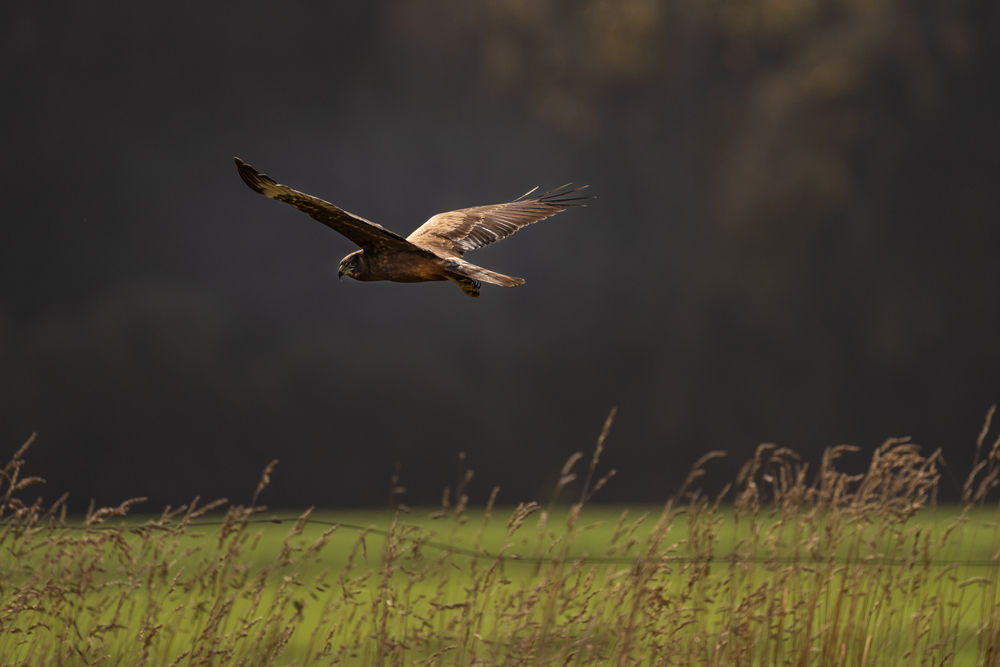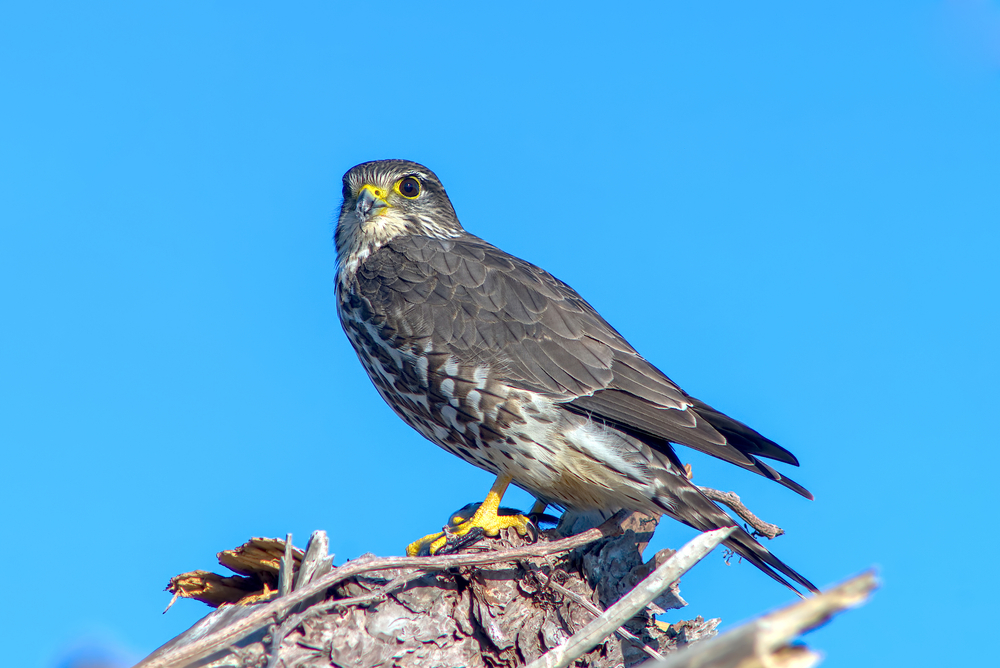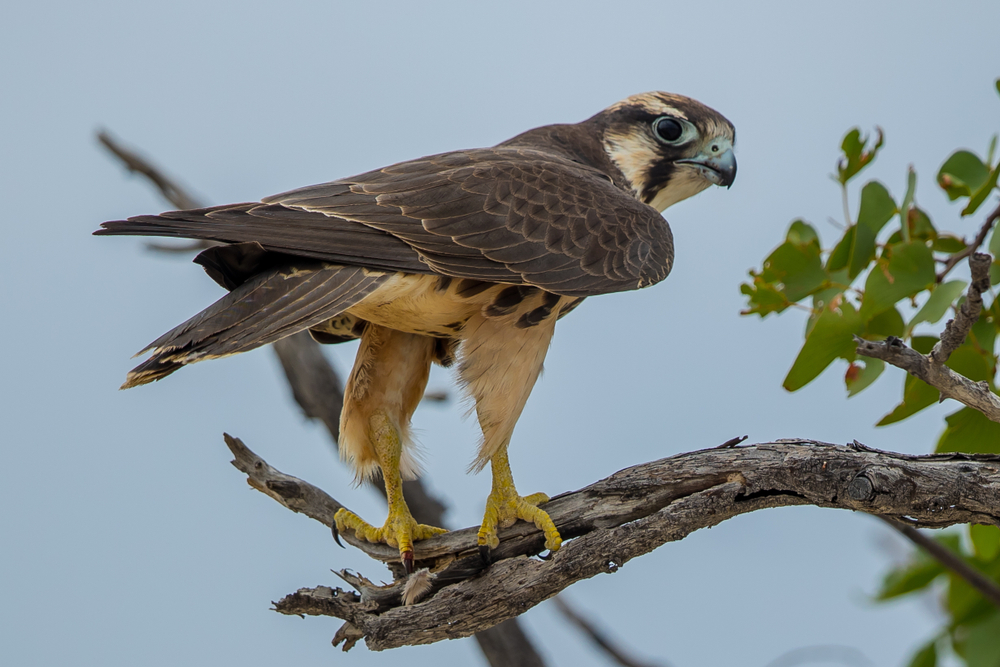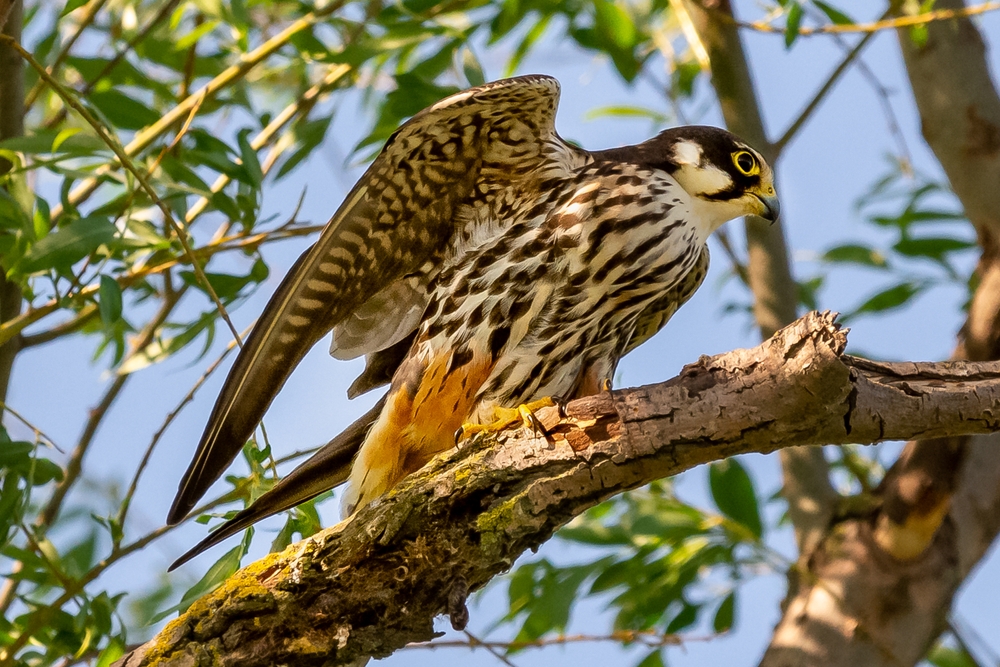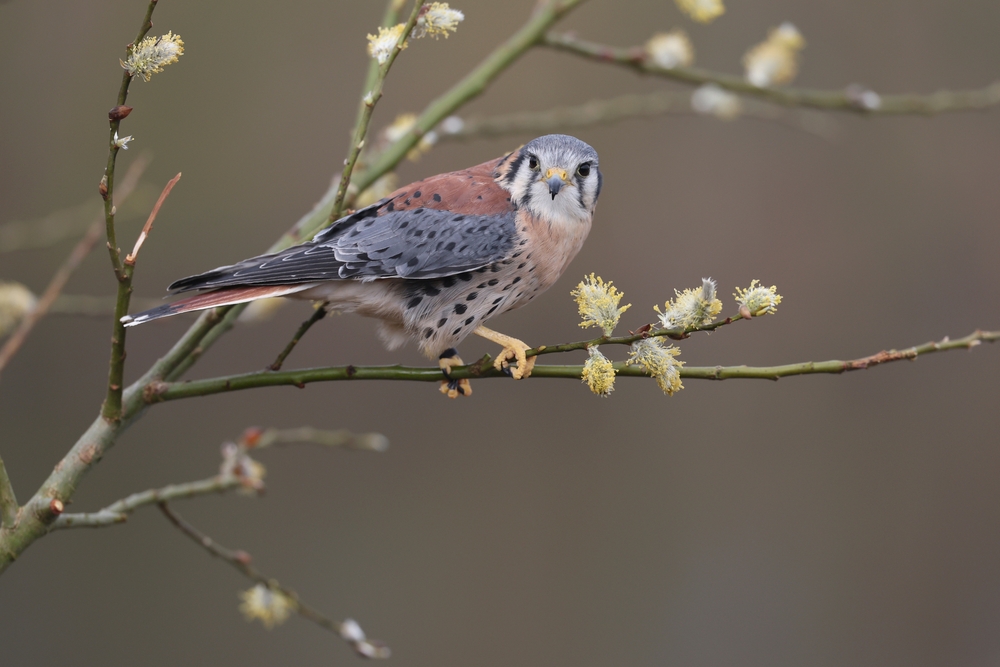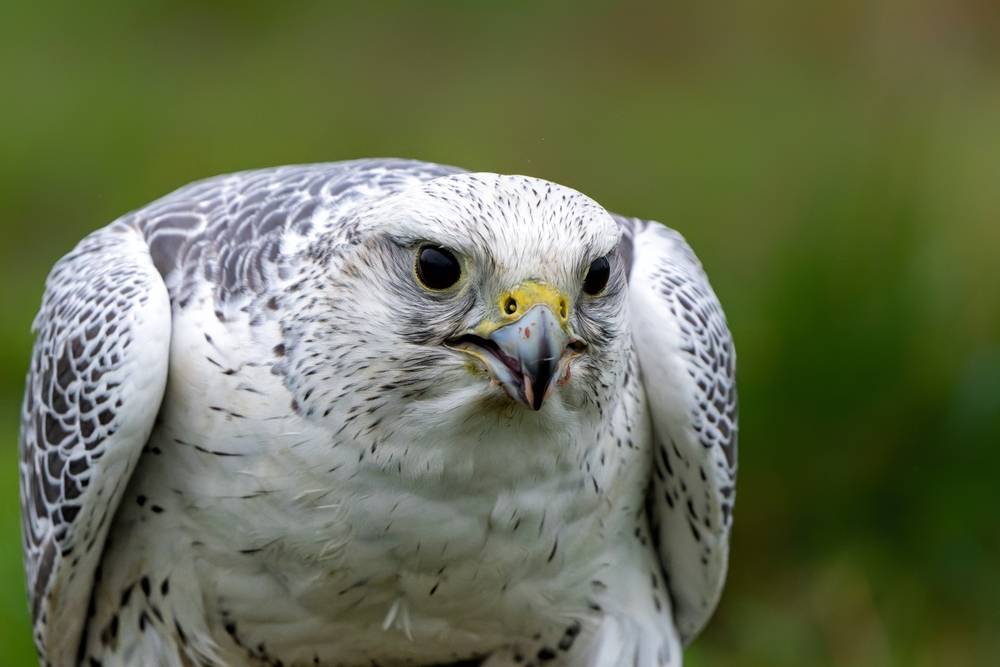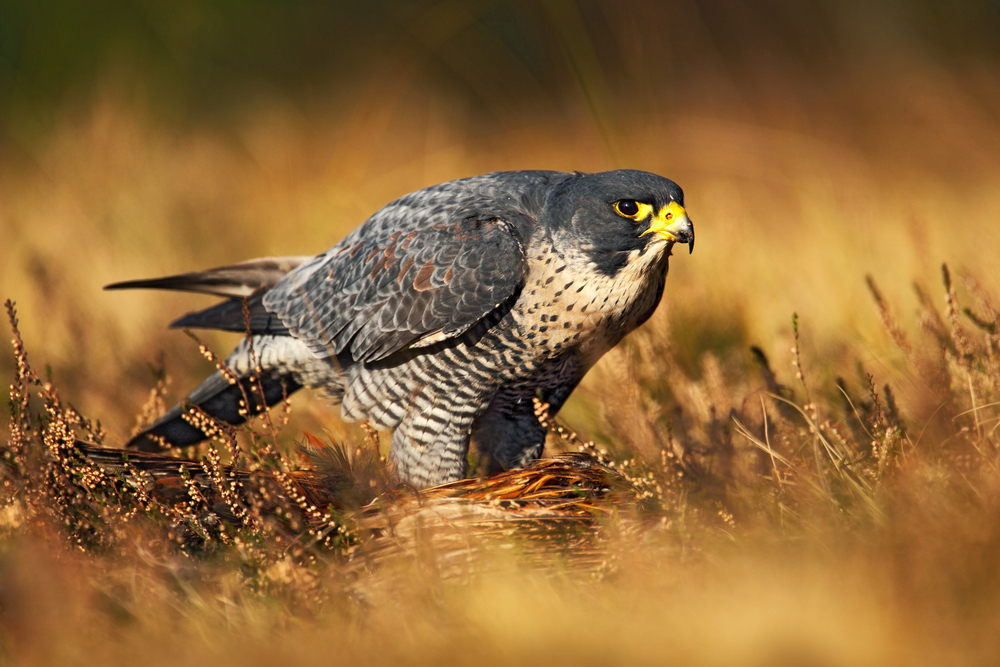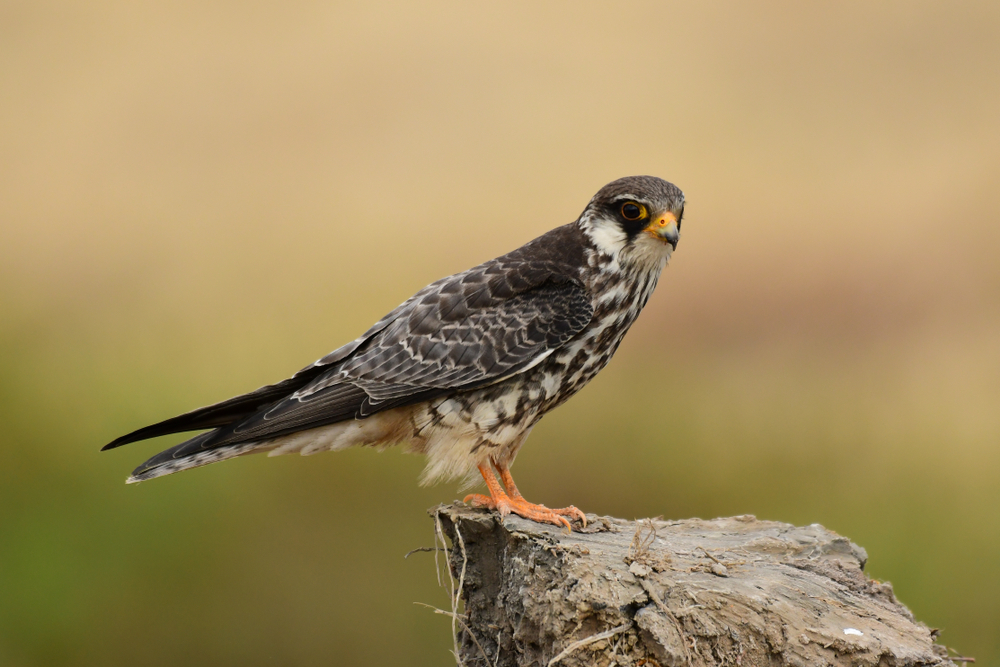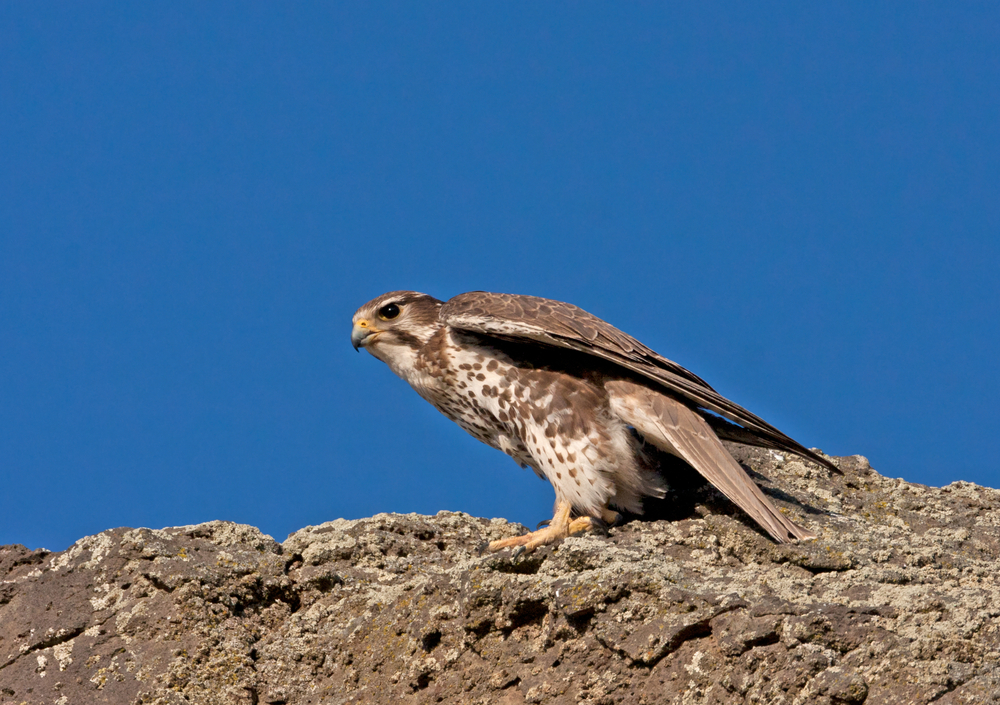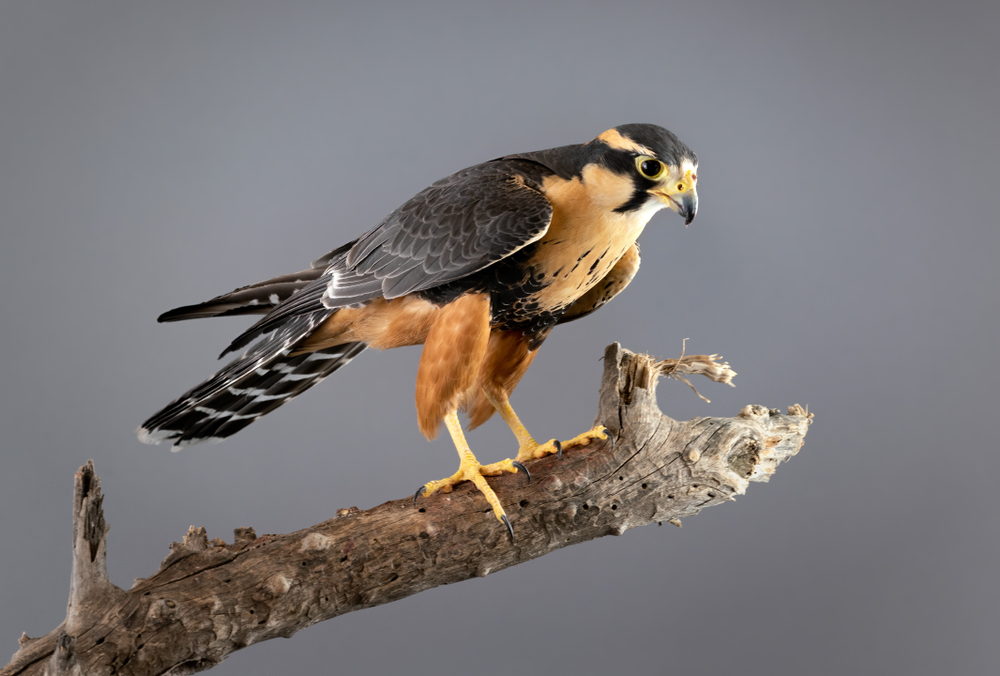The New Zealand Falcon (Falco novaeseelandiae) is most closely related to the Brown Falcon (Falco berigora) of Australia and the Nankeen Kestrel (Falco cenchroides), reflecting shared ancestry among Australasian falcons.
About
The New Zealand Falcon (Falco novaeseelandiae), also called the Kārearea, belongs to the Falconidae family and is the only falcon species native to New Zealand. Unlike the more common Australasian Harrier, the New Zealand Falcon is a true bird of prey that relies on speed, power, and agility to capture its quarry. It is highly significant in Māori culture and remains a symbol of strength, guardianship, and determination.
This medium-sized raptor is smaller than the Peregrine Falcon but larger than the Kestrel, with a wingspan of about 63–95 cm (25–37 in). It has long, pointed wings and a relatively long tail that allow swift maneuverability through forests as well as in open country. Adults are typically dark brown with a streaked breast and a distinctive yellow cere and eye ring.
The New Zealand Falcon is a bold and versatile hunter, preying on birds up to its own size, as well as mammals, lizards, and large insects. Unlike harriers, which scavenge frequently, falcons rely on live prey, striking with speed and powerful talons. They are known for their fearless behavior, sometimes attacking intruders near their nests, including humans.
Breeding takes place on cliffs, rocky outcrops, or even directly on the ground in open areas. A typical clutch contains 2–4 eggs. The female incubates while the male hunts, and after hatching, both parents fiercely guard the chicks. Despite their adaptability, their populations have declined due to habitat loss, predation by introduced mammals (such as stoats and cats), and collisions with vehicles.
Conservation efforts, including nest protection and public awareness campaigns, aim to safeguard this iconic species. Although classified as “At Risk – Recovering” in New Zealand, the Kārearea remains a vital part of the nation’s natural heritage and ecological balance.
Physical Characteristics
The New Zealand Falcon (Falco novaeseelandiae), locally known as the Kārearea, is a powerful, medium-sized falcon native to New Zealand, notable for its agility and aggressive hunting style.
Plumage:
-
Adults: Dark brown upperparts with lighter streaking, pale to rufous underparts heavily streaked with dark vertical lines, and a pale throat.
-
Juveniles: Generally darker overall, with buff streaking on the chest and less contrast between upper and lower parts.
-
Plumage varies slightly across subspecies, with some being darker in forested habitats and lighter in open-country regions.
Head and Face:
The head is proportionately large, with a sharp, hooked beak and bold dark eyes. A faint mustache stripe is present but less pronounced than in Peregrines.
Body and Wings:
The body is stocky yet streamlined, built for strength and maneuverability. Wings are long, pointed, and powerful, enabling high-speed pursuits and agile turns during hunting.
Tail:
The tail is long and rounded, with dark barring and a broad subterminal band, critical for balance and tight maneuvering through forests and open landscapes.
Size:
-
Length: 16–20 in (40–50 cm)
-
Wingspan: 30–39 in (76–100 cm)
-
Height at Rest: About 17 in (43 cm) when perched
Weight:
-
Adult Male: 0.5–1.0 lbs (230–450 g)
-
Adult Female: 1.0–2.2 lbs (450–1,000 g)
The New Zealand Falcon’s stocky build, dark streaked plumage, and long, banded tail distinguish it from harriers and other raptors in its range. Its combination of power and agility allows it to dominate as New Zealand’s top avian predator.
Reproduction
The New Zealand Falcon (Falco novaeseelandiae), or Kārearea, has a breeding cycle adapted to New Zealand’s temperate climate and diverse habitats, nesting in forests, tussock grasslands, and alpine regions.
1. Mating and Courtship:
Kārearea are generally monogamous, with pairs often staying together for several breeding seasons. Courtship includes aerial displays, calling, and prey deliveries from the male to the female.
2. Nesting Sites:
Unlike many falcons, they do not build nests. Instead, they create simple scrapes on the ground, cliff ledges, or in tree hollows. In forested regions, they may nest in cavities or epiphytes, while in alpine areas they use rocky ledges.
3. Egg Laying:
The female lays 2–4 eggs per clutch, usually from September to December (spring to early summer in New Zealand). Eggs are buff or reddish with darker speckles.
4. Incubation:
Incubation lasts about 30–33 days, carried out mostly by the female. The male provides food during this time and helps defend the nest.
5. Hatching and Care of Chicks:
Chicks hatch covered in white down and are highly vulnerable. The female broods them constantly in the first two weeks, while the male supplies prey. As chicks grow, both parents share feeding duties.
6. Fledging and Independence:
Young falcons fledge at about 30–35 days old. After fledging, they remain near the nest and are fed by the parents for several additional weeks, learning to fly and hunt.
7. Breeding Frequency:
Kārearea raise one brood per year, though in areas with abundant prey and suitable conditions, pairs may attempt a replacement clutch if the first fails.
The New Zealand Falcon’s flexible nesting behavior and strong parental care contribute to its survival, though ground-nesting pairs are particularly vulnerable to predation by introduced mammals such as stoats and cats.
Lifespan
The New Zealand Falcon (Falco novaeseelandiae), or Kārearea, has a moderate lifespan compared to other medium-sized falcons, though survival is heavily influenced by predation from introduced mammals and human-related threats.
Lifespan in the Wild:
In the wild, New Zealand Falcons typically live 8–12 years, though many do not survive their first year due to predation, starvation, or accidents. The oldest known wild individuals may reach 15 years under favorable conditions.
Lifespan in Captivity:
With protection from predators, steady food, and veterinary care, Kārearea can live up to 20 years in captivity.
Threats to the New Zealand Falcon:
-
Introduced Predators: Stoats, cats, ferrets, and rats prey on eggs, chicks, and sometimes adults.
-
Habitat Loss: Deforestation, land conversion, and wildfires reduce nesting and hunting grounds.
-
Human Conflict: Falcons are sometimes persecuted due to predation on poultry or racing pigeons.
-
Collisions: Window strikes, powerlines, and vehicle collisions contribute to mortality.
-
Climate Change: Altered prey availability and habitat changes may impact long-term survival.
Despite these threats, conservation programs—including predator control, nest protection, and captive breeding—have helped stabilize some local populations of the Kārearea.
Eating Habits
The New Zealand Falcon (Falco novaeseelandiae), or Kārearea, is a fierce and versatile hunter, known for its ability to take down prey larger than itself.
Diet:
-
Birds: Make up the majority of their diet, including pigeons, ducks, songbirds, starlings, and sparrows.
-
Mammals: Small mammals such as rats, mice, and rabbits, particularly in open-country habitats.
-
Insects & Reptiles: Will also feed on large insects (grasshoppers, beetles) and native lizards when available.
Hunting Strategy:
-
Aerial Pursuit: Skilled in fast, agile chases, often pursuing prey through forest canopies or over open fields.
-
Ground Attacks: Unlike many falcons, Kārearea also attack prey on the ground, surprising birds and mammals before they can escape.
-
Stealth & Ambush: They may launch sudden, low-level attacks from cover, relying on speed and surprise.
Feeding Behavior:
-
Prey is killed swiftly with a powerful bite to the neck or skull.
-
Small prey may be consumed on the spot, while larger prey is carried to a perch or nest.
-
During breeding, males deliver prey to the female, often passing food mid-air, and both parents feed chicks.
Success and Adaptability:
Kārearea are aggressive hunters capable of subduing birds larger than themselves, such as ducks and pheasants. Their adaptability across forests, farmland, alpine regions, and urban edges makes them New Zealand’s most versatile avian predator.
Uniqueness
The New Zealand Falcon (Falco novaeseelandiae), or Kārearea, is a remarkable raptor with distinctive traits that set it apart from other falcons.
Endemic Predator:
It is the only falcon species native to New Zealand, making it an important part of the country’s natural heritage and ecosystems.
Aggressive Hunting Style:
Kārearea are fearless hunters, capable of attacking prey larger than themselves, including ducks, pheasants, and even young rabbits. Unlike many falcons, they also strike prey on the ground as well as in flight.
Forest Hunting Ability:
They are among the few falcons adapted to chase prey through dense forests, displaying exceptional agility and maneuverability in tight spaces.
Cultural Significance:
The Kārearea holds a special place in Māori culture, symbolizing strength, swiftness, and guardianship. It appears in traditional legends, art, and modern New Zealand currency.
Conservation Importance:
Classified as At Risk – Recovering, the species faces threats from introduced predators and habitat loss but has benefited from predator control, nest protection, and conservation awareness programs.
Distinctive Appearance:
Its streaked brown plumage, long banded tail, and fierce gaze give it a more hawk-like appearance than many falcons, making it easily distinguished from the larger swamp harrier (Circus approximans) that shares its range.
The Kārearea’s status as New Zealand’s only native falcon, fearless hunting behavior, and cultural importance make it one of the most unique and iconic raptors of the Southern Hemisphere.
Be the First to Share Photos of This Species.
FAQ’s
1. What is the species closest to the New Zealand Falcon?
2. How does the New Zealand Falcon compare to other falcons?
The Kārearea is more aggressive and versatile than most falcons, capable of hunting prey larger than itself and adept at chasing through dense forests—something unusual among falcons that typically hunt in open skies.
3. Which national parks provide the best opportunities to see a New Zealand Falcon?
Which national parks provide the best opportunities to see a New Zealand Falcon?
-
Tongariro National Park (North Island): Frequently observed hunting in tussock grasslands and alpine zones.
-
Fiordland National Park (South Island): Seen soaring over forests and fjords.
-
Arthur’s Pass National Park (South Island): Reliable sightings in alpine and forested valleys.
-
Egmont National Park (North Island): Known for nesting in forest edges and open clearings.



































































